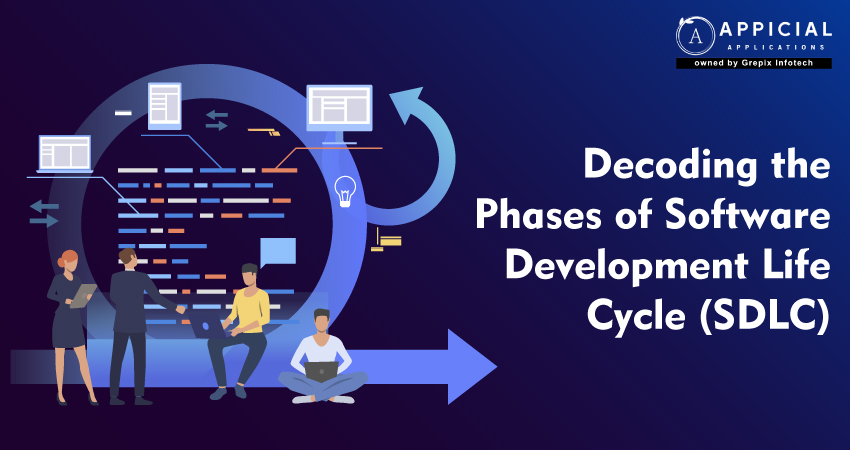
Decoding the Phases of Software Development Life Cycle (SDLC)
In the ever-evolving world of technology, the process of creating effective and efficient software is crucial. This is where the Software Development Life Cycle (SDLC) comes into play. SDLC is a systematic process used by software industry professionals to design, develop, and test high-quality software. In this blog post, we'll delve into what SDLC is, its importance, and the various phases that constitute this essential framework.
What is SDLC?
Software Development Life Cycle (SDLC) is an efficient and cost-effective process that development teams employ to create high-quality software within a reasonable timeframe. The objective of SDLC is to reduce project risks through careful planning, ensuring that the software not only meets but surpasses customer expectations both during production and in the long term. This approach details a sequence of steps that break down the software development process into assignable, achievable, and measurable tasks.
Gain a comprehensive understanding of the software development life cycle (SDLC) with our detailed guide. This blog post decodes the phases of SDLC, providing insights into each stage from planning to deployment. Whether you're a developer, project manager, or business owner, this guide offers valuable information to help you navigate the intricacies of software development and deliver successful projects.
Why is SDLC important?
SDLC is crucial because managing software development can be tough with shifting requirements, technology advancements, and the need for collaboration across various functions. This methodology offers a structured management framework with specific outcomes at each stage of the software development process. This ensures that all parties involved agree on the goals and requirements upfront, providing a clear plan to achieve them.
Some advantages of SDLC include:
- Enhanced transparency in the development process for all stakeholders.
- Streamlined estimation, planning, and scheduling.
- Improved management of risks and accurate cost estimation.
- Methodical software delivery, leading to higher customer satisfaction.
How does SDLC work?
The process of creating a software application is guided by the software development life cycle (SDLC), which breaks down various tasks. As developers enhance software by adding new features and addressing bugs, the development journey involves multiple stages.
The specific details of the SDLC process can differ among teams, but we'll outline some common phrases below.
1. Plan
During the planning phase, various tasks are undertaken, including cost-benefit analysis, scheduling, resource estimation, and allocation. The development team gathers requirements from different stakeholders, such as customers, internal and external experts, and managers, to craft a software requirement specification document. This document establishes expectations and outlines shared goals that assist in project planning. The team then assesses costs, devises a schedule, and formulates a detailed plan to attain their objectives.
2. Design
During the design phase, software engineers examine requirements and determine optimal solutions for creating the software. This involves considerations such as integrating existing modules, making technology choices, and selecting development tools. The focus is on figuring out the best way to integrate the new software into the organization's existing IT infrastructure.
3. Implement
In the implementation phase, the development team writes the code for the product. They break down the requirements into smaller coding tasks, working on these daily to achieve the final result.
4. Test
The development team employs a combination of automated and manual testing to inspect the software for bugs. Quality analysis involves checking for errors and ensuring that the software meets customer requirements. Since many teams test their code immediately after writing it, the testing phase often runs concurrently with the development phase.
5. Deploy
During software development, coding and testing occur on a separate copy of the software, distinct from the one users access. The software customers use is called production, while other copies are in the build or testing environment.
Maintaining separate build and production environments ensures that customers can still use the software while changes or upgrades are implemented. The deployment phase involves several tasks to transfer the latest build copy to the production environment, including packaging, configuring the environment, and installation.
6. Maintain
During the maintenance phase, the team addresses various tasks, including bug fixes, resolving customer issues, and overseeing software changes. Additionally, the team monitors the overall performance of the system, its security, and the user experience to discover new opportunities for enhancing the existing software.
What are SDLC Models?
SDLC models are conceptual frameworks that organize the software development life cycle (SDLC) in a structured manner, aiding organizations in its implementation. These models arrange the SDLC phases in different chronological orders to optimize the development cycle.
Let's explore some popular SDLC models below.
1. Waterfall
The waterfall model organizes all phases sequentially, where each new phase depends on the outcome of the previous one. Conceptually, the design flows from one phase to the next, akin to the cascading flow of a waterfall.
2. Iterative Model
The iterative process suggests starting software development with a small subset of requirements and gradually enhancing versions until the complete software is ready for production. At the end of each iteration, the team produces a new software version.
3. Spiral
The spiral model blends the small, repeated cycles of the iterative model with the linear, sequential flow of the waterfall model, emphasizing risk analysis. This model allows for the gradual release and enhancement of software by constructing prototypes at each phase.
4. Agile
The agile model organizes SDLC phases into multiple development cycles. The team rapidly iterates through these phases, introducing small, incremental changes to the software in each cycle. Continuous evaluation of requirements, plans, and results allows for quick responsiveness to change. The agile model, being both iterative and incremental, proves to be more efficient than other process models.
How SDLC Addresses Security
In traditional software development, security testing used to be a separate process from the software development life cycle (SDLC). The security team would only discover security flaws after building the software, resulting in numerous hidden bugs and heightened security risks.
Nowadays, most teams recognize that security is a crucial part of the software development life cycle. Addressing security in SDLC involves following DevSecOps practices and conducting security assessments throughout the entire SDLC process.
DevSecOps
DevSecOps involves seamlessly incorporating security testing at every step of the software development process. It incorporates tools and processes that foster collaboration among developers, security specialists, and operations teams to create software capable of withstanding modern threats. Additionally, it ensures that security assurance activities like code review, architecture analysis, and penetration testing are integral components of development efforts.
Comparison between Software Development Life Cycle and Systems Development Life Cycle
While the software development life cycle focuses on developing and testing software components, the systems development life cycle is a broader concept that involves the setup and management of software, hardware, people, and processes constituting a system. It includes tasks like organizational training and change management policies, extending beyond the scope of software development.
Systems Development Life Cycle
The acronym SDLC can also refer to the systems development life cycle, a process for planning and creating an IT system. This system typically comprises various hardware and software components working together to perform complex functions.
Application Life Cycle Management
Application life cycle Management (ALM) involves the creation and maintenance of software applications until they are no longer needed. It encompasses various processes, tools, and collaboration among individuals to manage all aspects of the life cycle, from ideation and design to development, testing, production, support, and eventual redundancy.
Conclusion
Understanding the phases of the Software Development Life Cycle (SDLC) is crucial for any successful project. As a mobile app development company, our deep dive into each phase of the SDLC has highlighted the importance of meticulous planning, design, implementation, testing, deployment, and maintenance. These stages ensure that software products are not only developed efficiently but also meet the highest standards of quality and functionality. By adhering to these well-defined phases, we can efficiently manage resources, mitigate risks, and ensure that the final product aligns with the client's vision and market needs. Our commitment to following the SDLC phases is a testament to our dedication to delivering top-tier software solutions. We believe that a thorough understanding and application of these phases is the key to creating successful, innovative, and impactful mobile applications.







